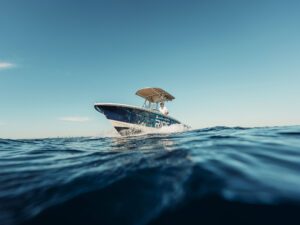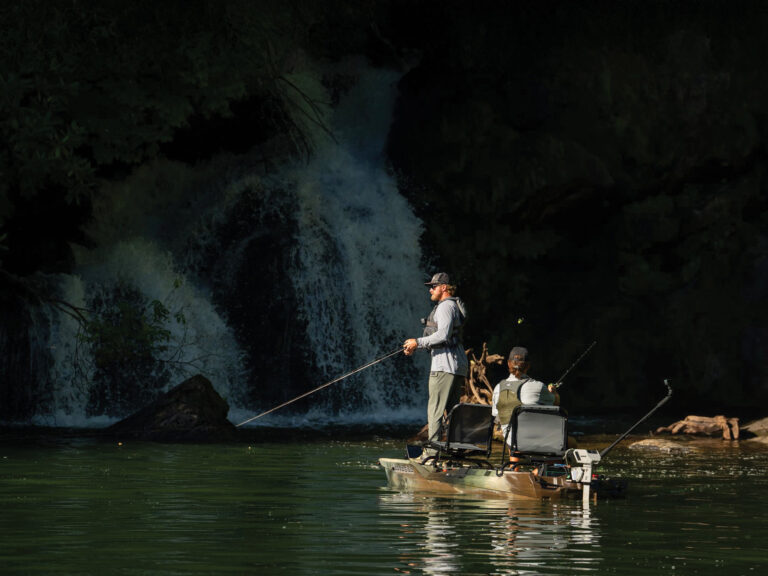More than a boat, Cobalt’s A28 is an expression of affluence and taste that allows its skipper to boast of having made it without saying a single word. Are those who buy one getting more than just bragging rights for their money?
Echoing the body styling of a first-generation Corvette, the A28’s deep topsides flutes taper aft, terminating at stainless-steel engine vents. Below these, protective quarter guards at the transom, where bumping a piling is most likely, narrow in width and decrease in height as they run forward: Sort of a high-profile boot stripe, these protect, yet won’t chafe or peel. The swim platform is low to the water for ease of access. Before entering the cockpit, note how low the deck is; that is, there is little height between the stainless-steel rub rail and the gunwale tops. Where’s the money?
A short deck, like that of the A28, can be narrower because the lamination crew doesn’t have to reach elbow-deep to roll out bubbles as they do aboard the taller decks of most boats. That means more width in the cockpit. Additionally, the low platform and those topsides flutes are created with reverse curves. Such shapes cannot be pulled from a single mold, the way most hulls are manufactured, any more than we could pop a cake from a pan with indented sides. Multipiece molds are required, costing more in time and labor. So, even at a glance, and from a distance, one begins to see why an A28 costs more than a comparable boat, like Sea Ray’s 270 SLX ($131,049 powered like our tester), even given that both boats might share the same engine options, utilize similarly high-quality upholstery and bejewel their bows with stainless-steel chafe plates.
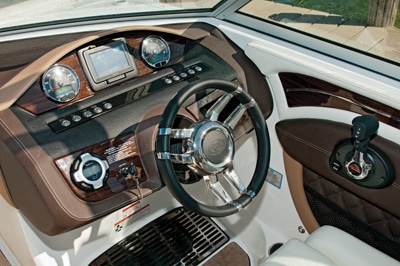
Stepping into the A28’s cockpit is easy from the transom walkway. But a clever folding lounge creates a safe step-in from the bow as well. This folding seat also allows crew members to sit facing forward with both feet on the sole, a more comfortable position in rougher water. Fold it open and the bow lounge reverts to deep, V-shape seating, allowing guests to face each other or enjoy snacks around the table ($774).
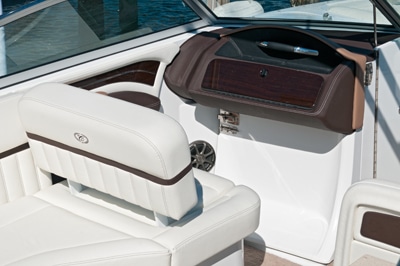
The standard aft cockpit table isn’t removable at all. Instead, it folds out from within the portside lounge, so there is no fiddling with pedestals — and no sockets in the sole to remain perpetually puddled. The lounge from which this table folds also features a flip-flop backrest, allowing crew to sit beside the skipper and face forward, or to recline and view the wake.
The transom lounge backrest is also a multiposition job, movable via a locking, cam-action lift-and-lay mechanism that we found both robust and easy to manipulate. With it, crew can choose sit or recline, facing either forward or aft.
Our tester was equipped with a hydraulic platform extension ($6,260) that drops below the waterline, granting skiers convenience in stepping into their bindings. It also works great for sitting waist deep in the water and facing the boat, the way you’d enjoy the pool bar at a high-end hotel. It is actuated by a pair of sterndrive trim rams and is powered by the sterndrive engine’s hydraulic trim pump. This precludes the need to install a separate system aboard, minimizing maintenance.
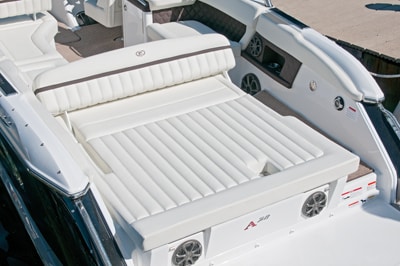
The head in the port console is a tight fit for adults but is equipped with a Corian vanity, a mirror, a fan and a light. It has a fiberglass sole, but the quarter-inch drain hole is too small for quick drainage.
At the wet bar, we flipped over the Corian sink cover to discover its underside can be used as a cutting board. The countertop is large, and the refrigerator ($1,848) below keeps chilled goods at hand.
Taking the helm, we found a flip-bolster seat with plenty of fore-and-aft travel. However, we bumped our heads on the stowed Bimini top for the optional arch ($14,064). The top Bimini is removable if you’re a 6-foot skipper who likes to stand while he runs.
Under way, we experienced a smooth and refined ride thanks to deep deadrise and the stiffness provided by the Kevlar reinforcement incorporated into the A28’s build. Bow rise was nil; we turned on a dime and felt connected to the water even at a top speed of 52.5 mph.
The question isn’t whether the A28 is worth it. The question is whether it’s worth it to you.
Comparable model: Sea Ray 270 SLX
**_ Click here for the Cobalt A28’s equipment list & here for an accommodation plan._
**
**
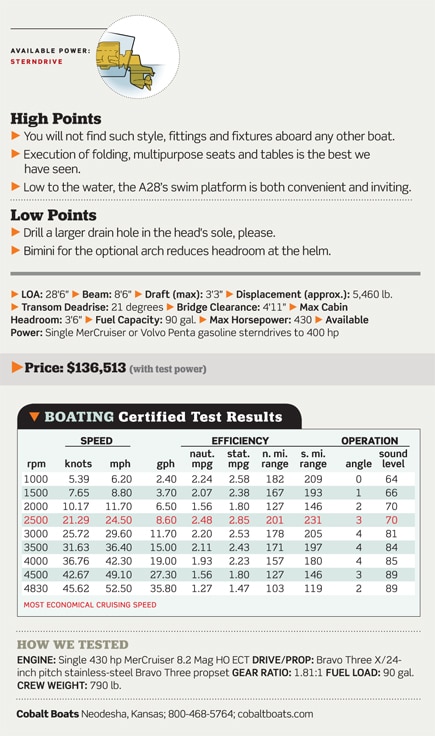
**



